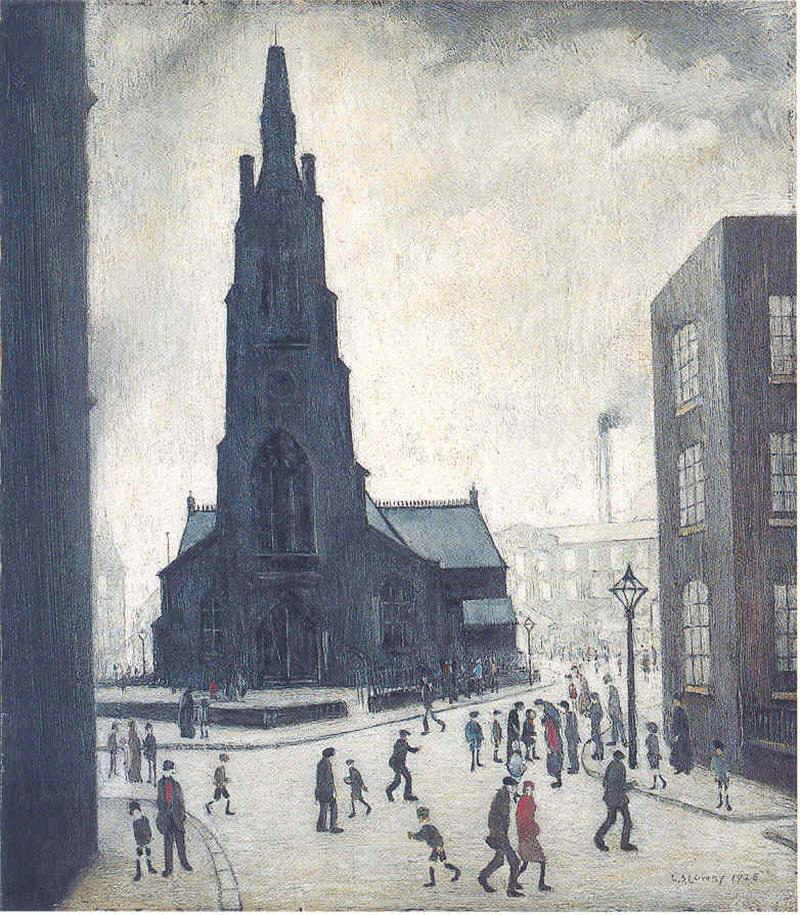Original; St. Simon's Church
L.S. Lowry
R.B.A., R.A.
"St. Simon's Church"
Image size
Original painting,

Lowry felt that drawings were as labour intensive to do as paintings. Working the surface of the drawings by smudging, erasing and rubbing
the pencil lines on the paper to build the ambiance of the drawing.
This artist would typically make fast sketches on the spot on no matter what paper he had in his pockets.
L.S.Lowry carefully composed his drawings in a painting room at home and took nice care over placing each figure.
Late in life he would sit before a canvas or board on his easel and never know what was going to be in the painting until he started working.
He would call them them "dreamscapes".
Bernard Taylor made the suggestion that helped Lowry achieve the stark figures and the pallor of the industrial sky
that he desired.
Taylor prompt Lowry painted on a pure white background. He experimented with layers of white paint on boards, leaving them for a time until
the surface became creamy.
LS Lowry used a really fundamental range of colours, which he mixed on his palette and painted on the white background.
"I'm a simple man, and use simple materials: ivory, black, vermilion (crimson), Prussian blue, yellow ochre, flake white and no medium (e.g. linseed oil).
That's all I've ever utilized in my paintings. I like oils... I like a medium you'll be able to work into over a time frame".
Examining the surface of a Lowry painting reveals to us the variety of ways he worked the paint with brushes (using both ends),
together with his fingers and with sticks or a nail.
Some paintings are painted over the surface of different images.
The 1938 portray Head of a Man (Man with Crimson Eyes) when x-rayed confirmed a female portrait and probably a self-portrait underneath.
Someone once asked,"What do you do along with your outdated suits?" "Wear them", got the reply!
Lowry actually wore them for work, wiping the brushes on his lapels and sleeves.
In 1932 the father of Lowry died . For the following seven years, his 73 year old mother became ill and fully ruled the life of Lowry.
After she died in 1939, Lowry painted "The Bedroom Pendlebury" - in memory of those lengthy hours he spent there.
Demanding an excessive amount of his attention, Lowry would usually only be able to arrive at his studio after dark.
"My mother didn't understand my artwork, however she understood me and that was enough" Lowry said.
These have been years of isolation and rising despair, mirrored in the paintings of Lowry.
They depict derelict buildings and wastelands as mirrors of himself. As an official warfare artist - himself emotionally blitzed -
Lowry drew the ruined shells of bombed-out buildings. In 1939, the year Mrs Lowry died - the particular person he most wanted to please -
success came with the first London exhibition.
"When the mother of Lowry died, all interest in life was lost, continuing to paint was his greatest salvation".
Just when this northern artist began to have success, Lowry was changing from the subjects that everybody wished him to produce.
"If it were not for loneliness, none of my works would have occurred". A few of the most powerful paintings by Lowry are abandoned landscapes and seascapes.
A number of the most difficult pictures to take pleasure in are of solitary figures and tramps.
"These folks affect me in a method that the industrial scene by no means did.
They are actual individuals, unhappy people.
Sadness attracts me, and there are some very unhappy things. similar feelings in myself".
All the things came too late for Lowry, but the later years saw the British artist turn out to be a famous celebrity.
Lowry also grew to become preoccupied about whether his art would last.
"Will I be remembered", he asked time and again, just like the art of the Pre-Raphaelites Lowry collected and cherished, "I painted from childhood to childhood".
Lowry grew to become an previous man - typically protesting to interviewers that he had "given up, packed it in".
LSLowry died aged 88 in 1976 just months before a retrospective exhibition of his paintings opened at the Royal Academy.
It broke all attendance records for a twentieth century artist.
Salford Museum & Art Gallery started amassing the artist's work in 1936
and steadily constructed the collection which is now held at the centre of the award-winning contemporary buiding bearing the artist's name.
Celebrating his art and changing the cityscape again.
A small quantity of paintings by the artist l.s. lowry have been published as signed limited prints.
Several of the most well-known being, 'Going to the match', Man lying on a wall, Huddersfield, Deal, ferry boats,
Three cats Alstow, Berwick-on-Tweed, peel park, The two brothers, View of a town, Road scene.
 England 01623 799 309 or mobile 07974 371 255
England 01623 799 309 or mobile 07974 371 255 All major credit/debit cards accepted
All major credit/debit cards accepted